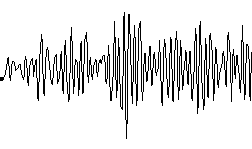In pulsed ultrasound Doppler velocimetry the sampling volume contains not a unique
particle but a lot of small particles having most of the time different shapes,
different sizes and different acoustic impedances.
As all of these particles contribute to generate a unique value of the amplitude
of the echo for each emission, the evolution of the echo amplitude will fluctuate.
The reason comes from the fact that some particles enter in the sampling volume
and others leave it. This fluctuation in amplitude will remain after the
demodulation process and will be present on the demodulated Doppler signal,
often called I and Q.
All the Doppler frequency shifts induced by the movement of the particles
are combined together. If all the particles do not have the same velocity
(in amplitude and in direction) the demodulated signals will contain many
Doppler frequencies. The resulting demodulated signals I and Q contain
therefore the combination of these two phenomena.
The figure gives an idea of the aspect of a real demodulated Doppler signal
corresponding to one gate.
The best way to analyze the frequency content of the demodulated echo signal
issued from one gate is to compute its power spectrum. The power spectrum gives
information on the distribution of the measured Doppler frequencies and their
relative influences on the computed mean Doppler frequency, which is computed
when the velocimeter displays the velocity profile.


